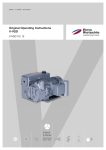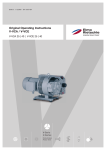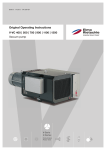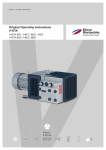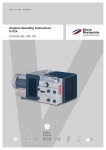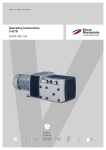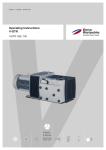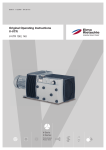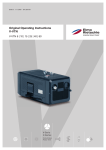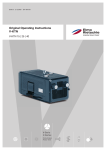Download Elmo Rietschle V-VCB 25 Operating instructions
Transcript
Edition: 1.12.2009 · BA 159-EN Original Operating Instructions V-VCB V V-VCB 20 | 25 V-Serie V-Series Drehschieber Rotary Vane Table of contents Table of contents 1 Foreword . . . . . . . . . . . . . . . . . . . . . . . . . . . . . . . . . . . . . . . . . . . . . . . . . . . . . . . . . . . . . . . . . . . 4 1.1 1.2 1.3 1.4 1.5 1.6 1.7 1.8 Principles . . . . . . . . . . . . . . . . . . . . . . . . . . . . . . . . . . . . . . . . . . . . . . . . . . . . . . . . . . . . . . . . . . . Target group . . . . . . . . . . . . . . . . . . . . . . . . . . . . . . . . . . . . . . . . . . . . . . . . . . . . . . . . . . . . . . . . . Supplier documentation and accompanying documents . . . . . . . . . . . . . . . . . . . . . . . . . . . . . . Abbreviations . . . . . . . . . . . . . . . . . . . . . . . . . . . . . . . . . . . . . . . . . . . . . . . . . . . . . . . . . . . . . . . . Directives, standards, laws . . . . . . . . . . . . . . . . . . . . . . . . . . . . . . . . . . . . . . . . . . . . . . . . . . . . . Symbols and meaning . . . . . . . . . . . . . . . . . . . . . . . . . . . . . . . . . . . . . . . . . . . . . . . . . . . . . . . . . Technical terms and meaning . . . . . . . . . . . . . . . . . . . . . . . . . . . . . . . . . . . . . . . . . . . . . . . . . . . Copyright . . . . . . . . . . . . . . . . . . . . . . . . . . . . . . . . . . . . . . . . . . . . . . . . . . . . . . . . . . . . . . . . . . . 4 4 4 4 4 5 5 5 2 Safety . . . . . . . . . . . . . . . . . . . . . . . . . . . . . . . . . . . . . . . . . . . . . . . . . . . . . . . . . . . . . . . . . . . . . 6 2.1 2.2 2.3 2.4 2.5 2.6 2.7 2.8 2.9 Warning instruction markings . . . . . . . . . . . . . . . . . . . . . . . . . . . . . . . . . . . . . . . . . . . . . . . . . . . General . . . . . . . . . . . . . . . . . . . . . . . . . . . . . . . . . . . . . . . . . . . . . . . . . . . . . . . . . . . . . . . . . . . . . Designated use . . . . . . . . . . . . . . . . . . . . . . . . . . . . . . . . . . . . . . . . . . . . . . . . . . . . . . . . . . . . . . Unacceptable operating modes. . . . . . . . . . . . . . . . . . . . . . . . . . . . . . . . . . . . . . . . . . . . . . . . . . Personal qualifications and training . . . . . . . . . . . . . . . . . . . . . . . . . . . . . . . . . . . . . . . . . . . . . . . Safety-conscious work . . . . . . . . . . . . . . . . . . . . . . . . . . . . . . . . . . . . . . . . . . . . . . . . . . . . . . . . Safety notes for the operator . . . . . . . . . . . . . . . . . . . . . . . . . . . . . . . . . . . . . . . . . . . . . . . . . . . . Safety instructions for installing, commissioning and maintenance . . . . . . . . . . . . . . . . . . . . . . Guarantee conditions . . . . . . . . . . . . . . . . . . . . . . . . . . . . . . . . . . . . . . . . . . . . . . . . . . . . . . . . . . 6 6 7 7 8 8 8 9 9 3 Transport, storage and disposal . . . . . . . . . . . . . . . . . . . . . . . . . . . . . . . . . . . . . . . . . . . . . . . . 10 3.1 3.3 Transportation . . . . . . . . . . . . . . . . . . . . . . . . . . . . . . . . . . . . . . . . . . . . . . . . . . . . . . . . . . . . . . . 3.1.1 Unpack and check the delivery condition . . . . . . . . . . . . . . . . . . . . . . . . . . . . . . . . . . 3.1.2 Lifting and transporting. . . . . . . . . . . . . . . . . . . . . . . . . . . . . . . . . . . . . . . . . . . . . . . . . Storage. . . . . . . . . . . . . . . . . . . . . . . . . . . . . . . . . . . . . . . . . . . . . . . . . . . . . . . . . . . . . . . . . . . . . 3.2.1 Ambient conditions for storage . . . . . . . . . . . . . . . . . . . . . . . . . . . . . . . . . . . . . . . . . . Disposal . . . . . . . . . . . . . . . . . . . . . . . . . . . . . . . . . . . . . . . . . . . . . . . . . . . . . . . . . . . . . . . . . . . . 10 10 10 11 11 11 4 Set up and operation . . . . . . . . . . . . . . . . . . . . . . . . . . . . . . . . . . . . . . . . . . . . . . . . . . . . . . . . . 12 4.1 4.2 4.3 Setup . . . . . . . . . . . . . . . . . . . . . . . . . . . . . . . . . . . . . . . . . . . . . . . . . . . . . . . . . . . . . . . . . . . . . . 4.1.1 Data plate . . . . . . . . . . . . . . . . . . . . . . . . . . . . . . . . . . . . . . . . . . . . . . . . . . . . . . . . . . . Description . . . . . . . . . . . . . . . . . . . . . . . . . . . . . . . . . . . . . . . . . . . . . . . . . . . . . . . . . . . . . . . . . Areas of application . . . . . . . . . . . . . . . . . . . . . . . . . . . . . . . . . . . . . . . . . . . . . . . . . . . . . . . . . . . 12 13 13 13 5 Installation . . . . . . . . . . . . . . . . . . . . . . . . . . . . . . . . . . . . . . . . . . . . . . . . . . . . . . . . . . . . . . . . . 14 5.1 5.2 5.3 5.4 5.5 Preparing for installation . . . . . . . . . . . . . . . . . . . . . . . . . . . . . . . . . . . . . . . . . . . . . . . . . . . . . . . Installation . . . . . . . . . . . . . . . . . . . . . . . . . . . . . . . . . . . . . . . . . . . . . . . . . . . . . . . . . . . . . . . . . . Connecting pipes . . . . . . . . . . . . . . . . . . . . . . . . . . . . . . . . . . . . . . . . . . . . . . . . . . . . . . . . . . . . Filling with lubricating oil . . . . . . . . . . . . . . . . . . . . . . . . . . . . . . . . . . . . . . . . . . . . . . . . . . . . . . . Connecting the motor . . . . . . . . . . . . . . . . . . . . . . . . . . . . . . . . . . . . . . . . . . . . . . . . . . . . . . . . . 14 14 15 15 16 6 Commissioning and decommissioning . . . . . . . . . . . . . . . . . . . . . . . . . . . . . . . . . . . . . . . . . . 17 6.1 Commissioning . . . . . . . . . . . . . . . . . . . . . . . . . . . . . . . . . . . . . . . . . . . . . . . . . . . . . . . . . . . . . . 6.1.1 Checking the rotation direction. . . . . . . . . . . . . . . . . . . . . . . . . . . . . . . . . . . . . . . . . . . Decommissioning/ storing . . . . . . . . . . . . . . . . . . . . . . . . . . . . . . . . . . . . . . . . . . . . . . . . . . . . . Re-commissioning . . . . . . . . . . . . . . . . . . . . . . . . . . . . . . . . . . . . . . . . . . . . . . . . . . . . . . . . . . . 17 18 18 18 3.2 6.2 6.3 2 | www.gd-elmorietschle.com © Gardner Denver Schopfheim GmbH, Gardner Denver Deutschland GmbH Table of contents 7 Maintenance and repair . . . . . . . . . . . . . . . . . . . . . . . . . . . . . . . . . . . . . . . . . . . . . . . . . . . . . . . 19 7.1 7.2 7.3 7.4 Ensuring operational safety . . . . . . . . . . . . . . . . . . . . . . . . . . . . . . . . . . . . . . . . . . . . . . . . . . . . . Maintenance work . . . . . . . . . . . . . . . . . . . . . . . . . . . . . . . . . . . . . . . . . . . . . . . . . . . . . . . . . . . . 7.2.1 Air filtering . . . . . . . . . . . . . . . . . . . . . . . . . . . . . . . . . . . . . . . . . . . . . . . . . . . . . . . . . . . 7.2.2 Coupling . . . . . . . . . . . . . . . . . . . . . . . . . . . . . . . . . . . . . . . . . . . . . . . . . . . . . . . . . . . . 7.2.3 Lubrication . . . . . . . . . . . . . . . . . . . . . . . . . . . . . . . . . . . . . . . . . . . . . . . . . . . . . . . . . . 7.2.4 Oil removal . . . . . . . . . . . . . . . . . . . . . . . . . . . . . . . . . . . . . . . . . . . . . . . . . . . . . . . . . . Repair/ Service . . . . . . . . . . . . . . . . . . . . . . . . . . . . . . . . . . . . . . . . . . . . . . . . . . . . . . . . . . . . . . . Spare parts. . . . . . . . . . . . . . . . . . . . . . . . . . . . . . . . . . . . . . . . . . . . . . . . . . . . . . . . . . . . . . . . . . 19 19 20 21 22 23 24 25 8 Malfunctions: Causes and elimination . . . . . . . . . . . . . . . . . . . . . . . . . . . . . . . . . . . . . . . . . . . 26 9 Technical Data . . . . . . . . . . . . . . . . . . . . . . . . . . . . . . . . . . . . . . . . . . . . . . . . . . . . . . . . . . . . . . 29 | 3 www.gd-elmorietschle.com © Gardner Denver Schopfheim GmbH, Gardner Denver Deutschland GmbH Foreword 1 Foreword 1.1 Principles These operating instructions: 1.2 • are a part of the following oil-flooded rotary vane vacuum pumps, V-VCB 20 and V-VCB 25. • describe how to use them safely and properly in all life phases. • must be available where the equipment is used. Target group The target group for these instructions is technically trained specialists. 1.3 Supplier documentation and accompanying documents Document Contents No. Operating Instructions BA 159-EN Declaration of Conformity C 0041-EN Declaration of harmlessness 7.7025.003.17 Spare parts’ list Spare parts document E 159 Data sheet Technical data and graphs D 159 Info sheet Water vapour compatibility for oil-flooded vacuum pumps I 200 Info sheet Storage guidelines for machines I 150 Manufacturer’s declaration EU Directive 2002/95/EG (RoHS) — Supplier documentation 1.4 Abbreviations 1.5 Fig. Figure V-VCB Vacuum pump m3/h Pumping capacity mbar (abs.) Final vacuum, operating vacuum Directives, standards, laws See Conformity Declaration 4 | www.gd-elmorietschle.com © Gardner Denver Schopfheim GmbH, Gardner Denver Deutschland GmbH Foreword 1.6 Symbols and meaning Symbol Explanation Condition, pre-requisite #### a), b),... Instructions, action Instructions in several steps Results [-> 14] Cross reference with page number Information, note Safety symbol Warns of potential risk of injury Obey all the safety instructions with this symbol in order to avoid injury and death. 1.7 Technical terms and meaning Term Explanation Machines Pump and motor combination ready to be connected Motor Pump drive motor Vacuum pump Machine to create a vacuum Rotary vane Machine’s design or active principle Pumping capacity Vacuum pump volume flow related to the condition in the suction connection Final pressure (abs.) The maximum vacuum that a pump reaches when the suction opening is closed. Given as absolute pressure. Permanent vacuum The vacuum or the suction range at which the pump operates permanently. The permanent vacuum or intake pressure is ≥ than the final vacuum and < than the atmospheric pressure. Noise emission 1.8 The noise emitted at a specific loading given as a figure, sound pressure level dB(A) as per EN ISO 3744.. Copyright Passing on or copying this document, using and providing information on its contents are prohibited unless expressly permitted. www.gd-elmorietschle.com © Gardner Denver Schopfheim GmbH, Gardner Denver Deutschland GmbH | 5 Safety 2 Safety The manufacturer is not responsible for damage if you do not follow all of this documentation. 2.1 Warning instruction markings Warning Danger level Consequences if not obeyed DANGER immediately imminent danger Death, severe bodily injury WARNING possible imminent danger Death, severe bodily injury CAUTION possible hazardous situation Slight bodily injury possible hazardous situation Material damage NOTICE 2.2 General These operating instructions contain basic instructions for installation, commissioning, maintenance and inspection work which must be obeyed to ensure the safe operation of the machine and prevent physical and material damage. The safety instructions in all sections must be taken into consideration. The operating instructions must be read by the responsible technical personnel/ operator before installing and commissioning and must be fully understood. The contents of the operating instructions must always be available on site for the technical personnel / operator. Instructions fixed directly onto the machine must be obeyed and must always remain legible. This applies for example to: • Symbols for connections • Data and motor data plate • Instruction and warning plates The operator is responsible for observing local regulations. 6 | www.gd-elmorietschle.com © Gardner Denver Schopfheim GmbH, Gardner Denver Deutschland GmbH Safety 2.3 Designated use The machine must only be operated in such areas as are described in the operating instructions: 2.4 • only operate the machine in a technically perfect condition • do not operate the machine when it is only partially assembled • the machine must only be operated at an ambient temperature and a suction temperature of between 12 and 40°C Please contact us for temperatures outside this range. • the machine may convey, compress or extract the following media: • Air The air extracted may contain water vapour but no water or other liquids. For water vapour compatibility see Info I 200 • all non-explosive, non-inflammable, non-aggressive and non-poisonous dry gases and gas air mixtures • extracting, conveying and compressing explosive, inflammable, aggressive or poisonous media, e.g. dust as per ATEX zone 20-22, solvents as well as gaseous oxygen and other oxidants • extracting, conveying and compressing explosive, inflammable, aggressive, oxidative or poisonous media, e.g. dust as per ATEX zone 20-22, solvents • using the machine in non-commercial plants if the necessary precautions and protective measures have not been taken in the plant • installing in environments that are at risk of explosions • using the machine in areas with ionising radiation • back pressures on the outlet side of more than +0,1bars • modifications to the machine and accessories Unacceptable operating modes www.gd-elmorietschle.com © Gardner Denver Schopfheim GmbH, Gardner Denver Deutschland GmbH | 7 Safety 2.5 Personal qualifications and training • Ensure that people entrusted with working on the machine have read and understood these operating instructions before starting work, particularly the safety instructions for installation, commissioning, maintenance and inspection work. • Manage the responsibilities, competence and monitoring of staff • all work must only be carried out be technical specialists: • Installation, commissioning, maintenance and inspection work • Working with electricity • 2.6 personnel being trained to work on the machine must be supervised by technical specialists only Safety-conscious work The following safety regulations apply in addition to the safety instructions and intended use listed in these instructions: 2.7 8 • Accident prevention regulations, safety and operating regulations • the standards and laws in force • hot parts of the machine must not be accessible during operation or must be fitted with a guard • People must not be endangered by the free extraction or discharge of pumped media • Risks arising from electrical energy must be eliminated. Safety notes for the operator | www.gd-elmorietschle.com © Gardner Denver Schopfheim GmbH, Gardner Denver Deutschland GmbH Safety 2.8 2.9 Safety instructions for installing, commissioning and maintenance • The operator will ensure that any installation, commissioning and maintenance work is carried out by authorised, qualified specialists who have gained sufficient information by an in-depth study of the operating instructions. • Only work on the machine when it is idle and cannot be switched on again • Ensure that you follow the procedure for decommissioning the machine described in the operating instructions. • Fit or start up safety and protective devices again immediately after finishing work. • Conversion work or modifications to the machine are only permissible with the manufacturer’s consent. • Only use original parts or parts approved by the manufacturer. The use of other parts may invalidate liability for any consequences arising. • Keep unauthorised people away from the machine Guarantee conditions The manufacturer’s guarantee or warranty will no longer apply in the following cases: • Improper use • Not complying with these instructions • Operation by insufficiently qualified staff • Using spare parts that have not been approved by Gardner Denver Schopfheim GmbH • Unauthorised modifications to the machine or the accessories supplied by Gardner Denver Schopfheim GmbH www.gd-elmorietschle.com © Gardner Denver Schopfheim GmbH, Gardner Denver Deutschland GmbH | 9 Transport, storage and disposal 3 Transport, storage and disposal 3.1 Transportation 3.1.1 Unpack and check the delivery condition a) Unpack the machine on receipt and check for transport damage. b) Notify the manufacturer of transport damage immediately c) Dispose of the packaging in accordance with the local regulations in force. 3.1.2 Lifting and transporting WARNING Death or limbs crushed as a result of the items being transported falling or tipping over. a) b) c) d) When transporting with the lifting device remember: Select the lifting device suitable for the total weight to be transported. Ensure that the machine cannot tip and fall. Do not stop under a suspended load. Put the goods to be conveyed on a horizontal base. Lifting device/ Transporting with a crane WARNING Bodily injury resulting from improper operation a) Loads crosswise to the ring level are not permitted. b) Avoid impact stress. 1 2 a) Tighten the fixing screw (Fig. 1/2) tightly to the transport shackle (Fig. 1/1) . b) The machine must be suspended on the transport shackle using the lifting device for lifting and transporting. Fig. 1/1 Lifting and transporting 1 Transport shackle 2 Fixing screw 10 | www.gd-elmorietschle.com © Gardner Denver Schopfheim GmbH, Gardner Denver Deutschland GmbH Transport, storage and disposal 3.2 Storage NOTICE Material damage caused by improper storage. Ensure that the storage area meets the following conditions: a) dust free b) vibration free 3.2.1 Ambient conditions for storage Ambient conditions Value Relative humidity 0% to 80% Storage temperature -10°C to +60°C For long-term storage (more than 3 months), it is useful to use a preservation oil rather than operating oil. See Info “Machine storage guidelines” I 150 3.3 Disposal WARNING Danger from inflammable, corrosive or poisonous substances. Machines that come into contact with hazardous substances must be decontaminated before disposal. a) b) c) d) e) When disposing ensure the following: Collect oils and grease separately and dispose of in accordance with the local regulations in force. Do not mix solvents, limescale removers and paint residues Remove components and dispose of them in accordance with the local regulations in force. Dispose of the machine in accordance with the national and local regulations in force. Parts subject to wear and tear (marked as such in the spare parts list) are special waste and must be disposed of in accordance with the national and local waste laws. www.gd-elmorietschle.com © Gardner Denver Schopfheim GmbH, Gardner Denver Deutschland GmbH | 11 Set up and operation 4 Set up and operation 4.1 Setup P P1 H M N O Q D A U B K I Q Q Q F E E E F F F Fig. 2 Vacuum pump V-VCB A Vacuum connection N Data plate B Exhaust air outlet O Rotation direction plate D Suction flange P Drive motor E Cooling air inlet P1 Motor data plate F Cooling air outlet Q hot surfaces > 70°C H Oil filling point U Gas ballast valve (version (07))) I Oil sight glass K Oil discharge point M Oil recommendation plate 12 | www.gd-elmorietschle.com © Gardner Denver Schopfheim GmbH, Gardner Denver Deutschland GmbH Set up and operation 4.1.1 Data plate 1 3 2 Bauj./Nr. 09 4 5 3~ Mot. 2847746 Typ VC 75 (20) 1026502067 0,5 mbar (abs.) 70 / 84 m³/h EN 60034 1,85 / 2,20 kW 1430 / 1720 min-1 S1 10 9 8 7 6 1 Type/ Size (mechanical version) 2 Year of construction 3 Motor design 4 Serial number 5 Item no. 6 Final pressure (abs.) 7 Pumping capacity 50 Hz/60 Hz 8 Speed 50 Hz/60 Hz 9 Motor output 50 Hz/60 Hz 10 Operating mode Fig. 3 Data plate (example) 4.2 Description The V-VCB has a fine micro filter on the suction side and on the outlet side an oil and oil mist separator to return the oil to the oil circulation system. A fan between the pump housing and the motor provides intensive air cooling. The fan is located in a fan cover that guards against it being touched. An integral non-return valve prevents the evacuated system from being ventilated after the pump has stopped. If the machine has been idle for more than two minutes the connected pipe should be ventilated to atmospheric pressure. A gas ballast valve ((U)➝ version (07)) prevents water vapour condensation from getting into the inside of the pump when it is sucking in small amounts of steam and the pump is at operating temperature.The pump is driven by a standard flanged single-phase or three-phase motor using a coupling. 4.3 Areas of application These oil-flooded rotary vane vacuum pumps V-VCB 20 and V-VCB 25 are suitable h for producing vacuums. The suction power with unrestricted suction is 20 and 22.5 m3/h at 50 Hz. Data sheet D 159. These types are suitable for the evacuation of closed systems or for a continuous vacuum within the following intake pressure ranges: 50 Hz ➝ 2 - 200 mbars (abs.) • 60 Hz➝ 2 - 150 mbars (abs.) If the machine is operated continuously outside these ranges there is the risk of oil leaking through the outlet opening. When evacuating closed systems the volume to be evacuated must be no more than 2% of the nominal pumping capacity of the vacuum pump. If the unit is switched on more frequently (at regular intervals of about 10 times an hour) or at higher ambient temperatures and intake temperatures, the excess temperature limit of the motor winding and the bearings may be exceeded.Please contact the manufacturer should the unit be used under such conditions. If it is installed in the open air the unit must be protected from environmental influences, (e.g. by a protective roof). www.gd-elmorietschle.com © Gardner Denver Schopfheim GmbH, Gardner Denver Deutschland GmbH | 13 Installation 5 Installation 5.1 Preparing for installation Check the following points: • • Machine freely accessible from all sides Do not close ventilation grids and holes • Sufficient room for installing and removing pipes and for maintenance work, particularly for installing and dismantling the machine • No external vibration effects • Do not suck any hot exhaust air from other machines into the cooling system. The oil filling pointFig. 2/H), oil sight glassFig. 2/I) and oil outletFig. 2/K) must be easily accessible. The cooling air inlets (Fig. 2/E) and the cooling air outlets (Fig. 2/F) must be at least 15 cm away from adjacent walls. Discharged cooling air must not be sucked in again.For maintenance work there must be a space of at least 30 cm around the machine. 5.2 Installation NOTICE The machine may only be operated when it is set up horizontally. Material damage resulting from the machine tipping over and falling. When installed at more than 1000 m above sea level a reduction in power is noticeable. In this case we would ask you to contact us. Ensure that the foundation complies with the following conditions: • Level and straight • The bearing surface must be at least the same size as the machine • The bearing surface must be able to bear the weight of the machine It is possible to install the machine on a firm base without anchoring. When installing on a substructure we recommend fixing with flexible buffers 14 | www.gd-elmorietschle.com © Gardner Denver Schopfheim GmbH, Gardner Denver Deutschland GmbH Installation 5.3 Connecting pipes NOTICE Material damage resulting from the forces and torques of the pipes on the unit being too high. Only screw pipes in by hand. The pumping capacity of the vacuum pump is reduced if the suction pipe is too narrow and/or too long. The air vent (Fig. 1/B) must not be closed or restricted. Counter pressures on the outlet side are only permissible up to + 0.1 bars. Prevent liquids accumulating in the exhaust line. a) Vacuum connection (Fig. 2/A). b) The extracted air can blow freely through the exhaust air opening (Fig. 2/B). 5.4 Filling with lubricating oil a) Fill the lubricating oil (for suitable types see the “Maintenance” section) via the oil filling point (Fig. 2/H) up to the upper edge of the sight glass (Fig. 2/I). b) Close the oil filling point. www.gd-elmorietschle.com © Gardner Denver Schopfheim GmbH, Gardner Denver Deutschland GmbH | 15 Installation 5.5 Connecting the motor DANGER Danger of death if the electrical installation has not been done professionally. The electrical installation must only be done by a qualified electrician observing EN 60204. The operating company has to provide the main switch. a) The motor‘s electrical data is given on the data plate (Fig. 2/N) or on the motor data plate (Fig. 2/ P1). The motors comply with DIN EN 60034 and are in protection class IP 55 and insulation class F. The appropriate connection diagram is located in the motor‘s terminal box (not for the plug connection version). The motor data must be compared with the data of the existing mains network (current type, voltage, network frequency, permitted current value). b. Connect the motor via the motor protection switch (for safety reasons, a motor protection switch is required and the connecting cable must be installed via a cable fitting to provide strain relief). We recommend using motor protection switches with delayed switch off, depending on possible excess current. Temporary excess current can occur when the machine is started cold.. NOTICE Power supply The conditions at the installation location must match the information on the motor data plate. Without derating the following is permissible: • ± 5% Voltage deviation • ± 2% Frequency deviation 16 | www.gd-elmorietschle.com © Gardner Denver Schopfheim GmbH, Gardner Denver Deutschland GmbH Commissioning and decommissioning 6 Commissioning and decommissioning 6.1 Commissioning WARNING Improper use May lead to severe or fatal injuries. Therefore be sure to obey the safety instructions. CAUTION Hot surfaces When the machine is at operating temperature the surface temperatures on the components (Fig. 1/Q) may go above 70°C. You must avoid touching the hot surfaces (marked with warning plates). CAUTION Noise emission The highest noise pressure levels measured as per EN ISO 3744 are given in Section 9. When spending a long time in the vicinity of the running machine use ear protectors to avoid permanent damage to your hearing CAUTION Oil aerosols in the extracted air In spite of the air oil removing system separating the oil mist to a large extent, the extracted air contains a small residue of oil aerosols. Breathing in these aerosols all the time could damage your health. Therefore you must ensure that the installation room is well ventilated www.gd-elmorietschle.com © Gardner Denver Schopfheim GmbH, Gardner Denver Deutschland GmbH | 17 Commissioning and decommissioning 6.1.1 Checking the rotation direction The drive shaft direction of rotation is shown by the rotation direction arrow (Fig. 2/O) on the motor flange. a) Start the motor briefly (max. two seconds) to check the direction of rotation. When looking at the motor fan, it must rotate anti-clockwise. NOTICE Incorrect direction of rotation Operating in the wrong direction of rotation leads to damage to the machine. Use a phase sequence indicator to check the direction of rotation (clockwise rotating field). b) After correcting the direction of rotation if necessary, start the motor again and stop it again after 2 minutes in order to top missing oil up to the upper edge of the sight glass (Fig. 2/I). This topping up at the filling point (Fig. 2/H) must be repeated until all the oil pipes have been filled completely. The filling point must not be open when the pump is running. 6.2 Decommissioning/ storing Stop the machine a) Switch the machine off. b) If available close the cut off device in the suction and pressure pipe. c) Disconnect the machine from the electricity source. d) Depressurise the machine: Open the pipes slowly . The pressure reduces slowly. e) Remove the pipes and hoses. f) Seal the connections for suction and discharge nozzles with adhesive foil. see also Section 3.2.1, Page 11 6.3 Re-commissioning a) Check the condition of the machine (cleanliness, cabling etc.). b) Drain the preserving agents. For installation see Section 5 Page 14 For commissioning see Section 6.1 Page 17 18 | www.gd-elmorietschle.com © Gardner Denver Schopfheim GmbH, Gardner Denver Deutschland GmbH Maintenance and repair 7 Maintenance and repair DANGER Danger of death from touching live parts. Before maintenance work disconnect the machine by pressing the main switch or unplugging it and ensure that it cannot be turned on again. WARNING Hot surfaces and equipment During maintenance work there is the danger of getting burnt on hot components (Fig. 2/Q) and by the machine lubricating oil. Wait for the machine to cool down. 7.1 Ensuring operational safety Regular maintenance work must be carried out in order to ensure operational safety. Maintenance intervals also depend on the operational demands on the machine. With any work observe the safety instructions described in Section 2.8 “Safety notes for installation, commissioning and maintenance”. The whole unit should always be kept in a clean condition. 7.2 Maintenance work Interval Maintenance to be carried out Section monthly Check the pipes and screws for leaks and to ensure they are seated properly and if necessary seal again or tighten up. — monthly Check the terminal box and cable inlet holes for leaks and if necessary re-seal. — monthly Clean the ventilation slots on the machine and the motor cooling ribs. — depending on how dirty the discharged medium is Clean intake air filter 7.2.1 at least once a year Check for coupling wear 7.2.2 daily Check the oil level 7.2.3 500 - 2000 h Change the oil 2000 hrs Change the oil separator element 7.2.4 www.gd-elmorietschle.com © Gardner Denver Schopfheim GmbH, Gardner Denver Deutschland GmbH | 19 Maintenance and repair 7.2.1 Air filtering f1 h Fig. 4 Air filtering D Suction flange h Non-return valve f1 Micro filter s1 Screws s2 Screws 20 | s2 D s1 NOTICE Insufficient maintenance on the air filter The power of the machine lessens and damage may occur to the machine. The micro filter (Fig. 4/f1) must be cleaned by rinsing out or purging or replaced more or less often depending on how dirty the discharged medium is. Also check the non-return valve (Fig. 4/h) for contamination. Remove the filter housing (Fig. 4/D) after undoing the screws (Fig. 4/s1). Remove the non-return valve (Fig. 4/h) from the suction flange after undoing the screws (Fig. 4/s2). Re-assemble in reverse order. www.gd-elmorietschle.com © Gardner Denver Schopfheim GmbH, Gardner Denver Deutschland GmbH Maintenance and repair 7.2.2 Coupling The coupling rubbers (Fig. 5/k) are subject to wear and und must be checked regularly (at least once a year).. You can tell when the coupling rubbers are worn by a knocking noise when the pump starts up. m q s4 CAUTION s5 Defective coupling rubbers Defective coupling rubbers may lead to the rotor shaft breaking l1 v1 l k q1 r v u Fig. 5 Coupling k Coupling rubber l Retaining ring l1 Retaining ring m Motor q Coupling half on the motor side q1 Coupling half on the pump side r Coupling bolt s4 Screw s5 Screw u Washer v Fan v1 Fan cover w Nut w To check the coupling switch the motor (Fig. 5/m) off and ensure that it cannot be switched on again.. Undo screws (Fig. 5/s4) . Remove the machine axially with the coupling half on the pump side (Fig. 5/q1). If the coupling rubbers (Fig. 5/k) are damaged remove the retaining rings (Fig. 5/l) from the coupling bolts (Fig. 5/r) and replace the coupling rubbers (Fig. 5/k). Check and if necessary replace the coupling bolts (Fig. 5/r): Remove the retaining ring (Fig. 5/l1). Remove the coupling half on the pump side (Fig. 5/q1) and the fan (Fig. 5/v) from the pump shaft. Undo the nuts (Fig. 5/w) and the washers (Fig. 5/u) and replace the coupling bolts. NOTICE Frequent starting up and high ambient temperature The service life of the sprocket (Fig. 6/k) is reduced as a result of this. Re-assemble in reverse order. www.gd-elmorietschle.com © Gardner Denver Schopfheim GmbH, Gardner Denver Deutschland GmbH | 21 Maintenance and repair 7.2.3 Lubrication H M NOTICE Always change the oil when the machine is at operating temperature and in an atmospherically ventilated area. If it is not completely emptied the amount that can be refilled is reduced. The waste oil must be disposed of in compliance with the local environmental protection regulations. If you are going to use another oil type, empty the oil removing device housing and oil cooler completely. K I Fig. 6 Lubrication H Oil filling point I Oil sight glass K Oil discharge point M Oil recommendation plate 22 | The oil level must be checked at least once a day, if necessary top the oil up to the upper edge of the sight glass (Fig. 6/I) First oil change after 500 hours of operation. Subsequent oil changes after 5002000 hours of operation. Reduce the change intervals accordingly depending on how contaminated the discharged medium is. Only lubricating oils complying with DIN51506 group VC/VCL or a synthetic oil approved by Elmo Rietschle must be used. The viscosity of the oil must comply with ISO-VG46 as per DIN51519.Elmo Rietschle oil types: MULTI-LUBE 46 (mineral oil) and SUPER-LUBE46 (synthetic oil) see also oil recommendation plate (Fig. 6/M)). If the oil is subject to high temperatures (ambient or intake temperatures over 30°C, insufficient cooling, 60 Hz operation etc.) the oil change interval may be extended by using the recommended synthetic oil. www.gd-elmorietschle.com © Gardner Denver Schopfheim GmbH, Gardner Denver Deutschland GmbH Maintenance and repair 7.2.4 Oil removal t1 L L1 Fig. 7 Oil removal L Oil separator element L1 O ring T Purging cover s3 Screws T s3 WARNING Heavily contaminated air oil removing devices lead to increased pump temperatures and in extreme cases may cause the lubricating oil to ignite spontaneously. The oil separator element may be contaminated with particles of dirt when it has been running for a long time (power consumption and pump temperature increase). Replace the device (Fig. 7/L) every 2000 operating hours because it is not possible to clean it. Reduce the change intervals accordingly depending on how contaminated the discharged medium is. Changing: Remove the purging cover (Fig. 7/T) and the gasket after undoing the screws (Fig. 7/s3). Unscrew the oil separator element (Fig. 7/L) with a hexagonal wrench (size 10) and replace. NOTICE Ensure that the O ring is correctly seated on the new oil separator element. Re-assemble in reverse order. Before fitting lightly oil the O ring Fig. 7/L1) on the new oil removing device and tighten it to 15 Nm. www.gd-elmorietschle.com © Gardner Denver Schopfheim GmbH, Gardner Denver Deutschland GmbH | 23 Maintenance and repair 7.3 Repair/ Service a) For on site repair work the motor must be disconnected from the mains by a qualified electrician so that it cannot be started up again accidentally. For repairs use the manufacturer, its branch offices or authorised dealers. Please contact the manufacturer for the address of the service centre responsible for you (see Manufacturer’s address). NOTICE For each machine that is sent to an Elmo Rietschle Service centre for inspection, maintenance or repair, a fully completed, signed declaration of harmlessness must be enclosed. The declaration of harmlessness is part of the supplier‘s documentation b) After a repair or re-commissioning, the actions listed under “Installation” and “Commissioning” must be carried out as for initial commissioning.. Fig. 8 24 Clearance certificate 7.7025.003.17 | www.gd-elmorietschle.com © Gardner Denver Schopfheim GmbH, Gardner Denver Deutschland GmbH Maintenance and repair 7.4 Spare parts Order spare parts in accordance with the: • Spare parts list: E 159 ➝ V-VCB • Download the PDF file: http://www.gd-elmorietschle.com ➝ Downloads ➝ Product Documents ➝ V-Series ➝ Spare Parts • Parts subject to wear and gaskets are indicated separately on the list. • Web site: http://www.service-er.de • Select the type, size and design. NOTICE Only use original spare parts or parts approved by the manufacturer. The use of other parts may lead to malfunctions and invalidate liability or the guarantee for any consequences arising Fig. 9 Spare parts list (example) Fig. 10 Web site http://www.service-er.de www.gd-elmorietschle.com © Gardner Denver Schopfheim GmbH, Gardner Denver Deutschland GmbH | 25 Malfunctions: Causes and elimination 8 Malfunctions: Causes and elimination Fault Cause Troubleshooting Important Machine is switched off by the motor protection switch Mains voltage/ Frequency does not correspond with the motor data Check by qualified electrician Section 5.5 Connection to motor terminal board is not correct Motor protection switch is not set correctly Pumping capacity is insufficient 26 | Motor protection switch is triggered too quickly Use a motor protection switch with an overload-dependent delayed switch off that takes into consideration the short term excess current at start up (version with short circuit and overload trigger as per VDE 0660 Part 2 orIEC 947-4) Vacuum pump or its oil is too cold Note the ambient temperature and the intake temperature Section 2.3 The lubricating oil is too viscous The oil viscosity must comply with ISO VG 46 as per DIN 51519 Section 7.2.3 The oil separator element is dirty. Change the oil separator element Section 7.2.4 The back pressure is too high when the exhaust air is being discharged. Check the hose or the pipe Section 5.3 The suction pipe is too long or too narrow Check the hose or the pipe Section 5.3 Leak on the suction side of the vacuum pump or in the system Check the pipework and screw connections for leaks and to ensure that they are firmly seated. Section 7.2 The intake filter is dirty Clean or replace the intake filter Section 7.2.1 www.gd-elmorietschle.com © Gardner Denver Schopfheim GmbH, Gardner Denver Deutschland GmbH Malfunctions: Causes and elimination Fault Cause Troubleshooting Important Final pressure (max. vacuum) is not reached Leak on the suction side of the vacuum pump or in the system Check the pipework and screw connections for leaks and to ensure that they are firmly seated. Section 7.2 Incorrect oil viscosity The oil viscosity must comply with ISO VG 46 as per DIN 51519 Section 7.2.3 Ambient or intake temperature is too high Ensure it is being used properly Section 2.3 Cooling air supply is obstructed Check environmental conditions Section 5.1 Clean ventilation slots Section 7.2 The lubricating oil is too viscous The oil viscosity must comply with ISO VG 46 as per DIN 51519 Section 7.2.3 The oil separator element is dirty. Change the oil separator element Section 7.2.4 The back pressure is too high when the exhaust air is being discharged. Check the hose or the pipe Section 5.3 The oil separator element is not inserted correctly or the O ring is missing Check that it is correctly seated Section 7.2.4 Unsuitable oil is being used Use suitable types Section 7.2.3 The oil separator element is dirty. Change the oil separator element Section 7.2.4 The back pressure is too high when the exhaust air is being discharged. Check the hose or the pipe Section 5.3 Ambient or intake temperature is too high Ensure it is being used properly Section 2.3 Cooling air supply is obstructed Check environmental conditions Section 5.1 Clean ventilation slots Section 7.2 Machine gets too hot Exhaust air contains visible oil mist www.gd-elmorietschle.com © Gardner Denver Schopfheim GmbH, Gardner Denver Deutschland GmbH | 27 Malfunctions: Causes and elimination Fault Cause Troubleshooting Important The vacuum pump produces a abnormal noise (The blades making a hammering noise when starting from cold is normal if it disappears within two minutes as the operating temperature increases) The coupling rubbers are worn Replace coupling rubbers Section 7.2.2 The pump housing is worn (chatter marks) Repair by manufacturer or authorised workshop Elmo Rietschle Service Blades are damaged Repair by manufacturer or authorised workshop Elmo Rietschle Service Vacuum pump or its oil is too cold Note the ambient temperature and the intake temperature Section 2.3 The lubricating oil is too viscous The oil viscosity must comply with ISO VG 46 as per DIN 51519 Section 7.2.3 Pump sucks in water Install water interceptor upstream of the pump The pump sucks in more water vapour than is suitable for its water vapour compatibility Contact the manufacturer for increased gas ballast Pump only works for a short time and therefore does not reach its normal operating temperature Let the pump continue to run with a closed suction side after extracting the water vapour until the water has evaporated from the oil Water in lubricating oil — — — Please contact Elmo Rietschle Service for other malfunctions or those that cannot be eliminated. 28 | www.gd-elmorietschle.com © Gardner Denver Schopfheim GmbH, Gardner Denver Deutschland GmbH Technical Data 9 Technical Data V-VCB Sound pressure level (max.) EN ISO 3744 Tolerance± 3 dB(A) 20 25 50 Hz 67 67 60 Hz 68 69 dB(A) Weight* kg 23 Length* mm 410 Width mm 236 Height mm 168 G 1/2 Vacuum connection Correct amount of oil l 0,35 * The length and the weight may differ from the information listed here depending on the motor design. abweichen. You will find more technical data on the data sheet D 159 • Download the PDF file: D 159 ➝ V-VCB • Download the PDF file: http://www.gd-elmorietschle.com ➝ Downloads ➝ Product Documents ➝ V-Series ➝ Data Sheets NOTICE Subject to technical changes. Fig. 11 Datenblatt (Beispiel) www.gd-elmorietschle.com © Gardner Denver Schopfheim GmbH, Gardner Denver Deutschland GmbH | 29 www.gd-elmorietschle.com [email protected] Gardner Denver Schopfheim GmbH Roggenbachstraße 58 79650 Schopfheim · Deutschland Tel. +49 7622 392-0 Fax +49 7622 392-300 Elmo Rietschle is a brand of Gardner Denver‘s Industrial Products Division and part of Blower Operations. EC - declaration of conformity 2006/42/EC Hereby the manufacturer confirms: Gardner Denver Schopfheim GmbH Postfach 1260 D-79642 Schopfheim that the machine: of the: Oil lubricated vacuum pump Series: V-VCB Type: V-VCB 20, V-VCB 25 is conform to the regulations of the guideline indicated above. The following harmonized and national standards and specifications are applied: EN 1012-1:2010 Compressors and vacuum pumps — Safety requirements — Part 1: Compressors EN 1012-2:1996+A1:2009 Compressors and vacuum pumps — Safety requirements — Part 2: Vacuum pumps These declarations of conformity are invalid when the machine has been modified without prior approval by us and the approval has been documented in writing. Name and address of the EC person in charge for documentation Gardner Denver Schopfheim GmbH Postfach 1260 D-79642 Schopfheim Gardner Denver Schopfheim GmbH Schopfheim, 1.8.2011 Dr. Friedrich Justen, Director Engineering C_0041_EN Safety declaration form for vacuum pumps and components 7.7025.003.17 Page 1 of 1 Gardner Denver Schopfheim GmbH Roggenbachstr. 58, 79650 Schopfheim Phone: +49/(0)7622/392-0 Fax: +49/(0)7622/392-300 Repairs and/or maintenance of vacuum pumps and components will only be carried out if a declaration has been filled in correctly and completely. If not, the repair work cannot be started and delays will result. This declaration must only be filled in and signed by authorised qualified staff. 1. Type of vacuum pumps/ components 2. Reason for the submission Type description: Machine number Order number: Delivery date: 3. Condition of vacuum pumps/ components YES NO 4. Contamination of the vacuum pumps/ components when in use Toxic YES NO Corrosive YES NO Was the pump/ component emptied? Microbiological*) YES NO (Product/Consumables) YES NO Explosive*) YES NO Has the pump/ component been cleaned and decontaminaRadioactive*) YES NO other YES NO YES Was this being operated? Which lubrication was used? Cleaning agent: Cleaning method: *) Microbiological, explosive or radioactively contaminated vacuum pumps/ components will only be accepted with proof that they have been cleaned properly. Type of toxic substance or process-related, dangerous reaction products with which the vacuum pumps/ components came into contact: Trade name, manufacturer's product name 1 2 3 4 Chemical name Hazard class Action to be taken if toxic substances are released First aid in the event of accidents Personal protection measures: YES Hazardous decomposition products when subjected to thermal load NO Which? 5. Legally binding declaration We swear that the information in this declaration is accurate and complete and that I, the undersigned, am in a position to judge this. We are aware that we are liable to the contractor for damage caused by incomplete and inaccurate information. We undertake to release the contractor from any damage claims from third parties arising from incomplete or incorrect information. We are aware that, regardless of this declaration, we are directly liable to third parties including in particular the contractor's staff entrusted with handling or repairing the product. Company: Street: Post code/ Town: Phone: Fax: Name (in capitals) Date: Position: Company stamp: Legally binding signature: TOS no. / Index: 7.7025.003.17 / 03 Office responsible: GS File management: ..\7702500317.xl Gardner Denver Schopfheim GmbH Postfach 1260 D-79642 Schopfheim
































